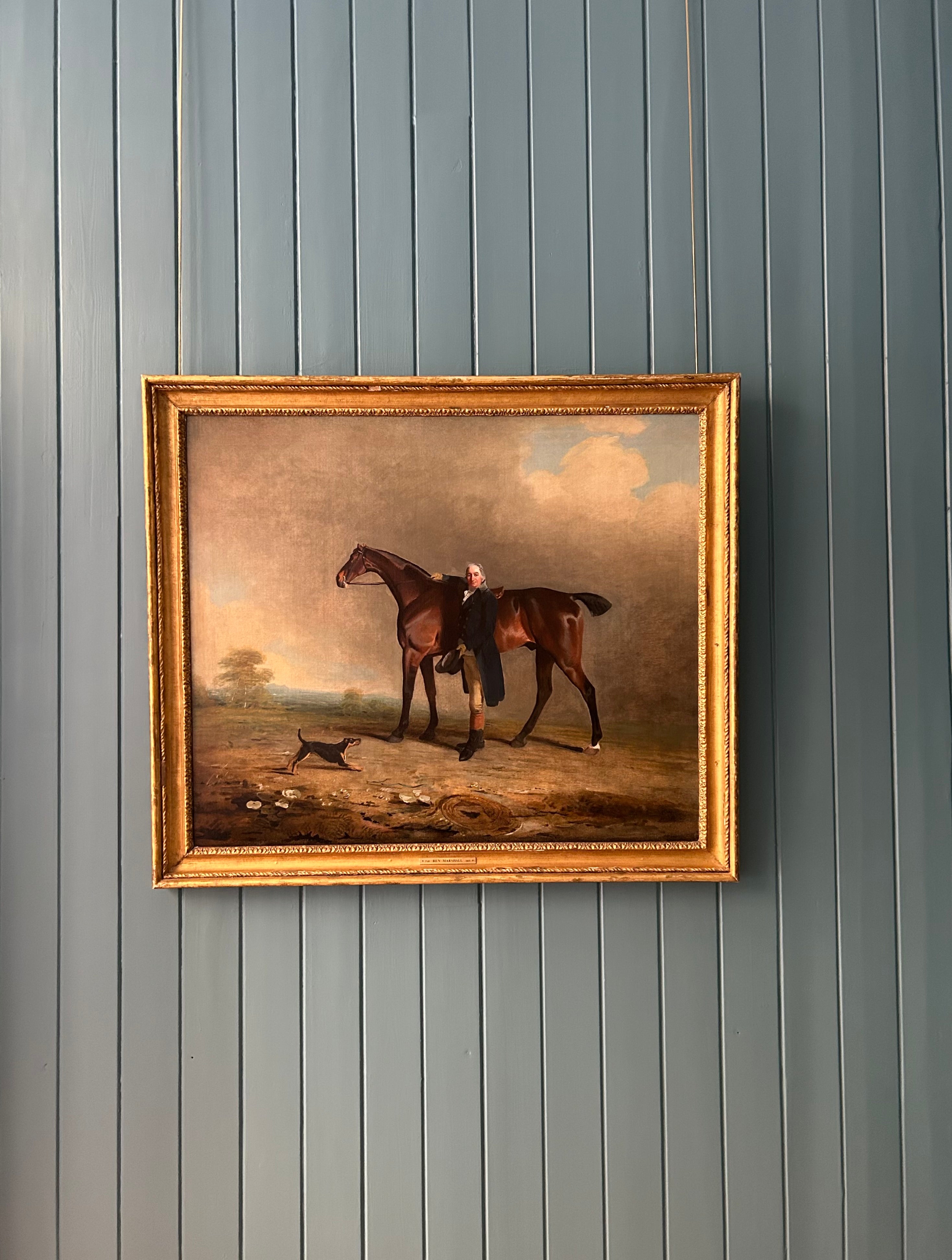

Benjamin Marshall
The Right Honourable Peniston Lamb, 1st Viscount Melbourne with Horse and Dog
Oil on canvas
Image size: 33 x 39 1/4 inches (83.8 x 99.7 cm)
Original gilt frame
Provenance
Arthur Ackermann & Son, Ltd., London
Christie's, New York, 4 June 1982
Christie's London, Sporting Art, 22 May 2003
Private collection
Exhibited
London, Basil Dighton, 3 Savile Row, Old Sporting Prints, 1913, no. 121, illustrated as frontispiece
London, Arthur Ackermann & Son, Ltd., Annual Exhibition of Sporting Paintings, 1982, no. 38.
This equine portrait depicts The Right Honourable Peniston Lamb (1745 – 1828) in hunting attire looking out towards the viewer, his right hand holding the bridle of his majestic bay Hunter horse. In the lower left of the painting, a black and tan hunting terrier crouches in an alert and playful position, eagerly looking towards his master.
The portrait bears many similarities to an earlier work depicting the Honourable Peniston Lamb, with his bay Hunter Assassin and his black and tan hunting terrier Tanner. In this portrait, Lamb even wears the same hunting attire. It is possible, therefore, that this painting is a commission undertaken by Marshall for Lamb.
The painting demonstrates a number of masterful characteristics. The expansive sky and landscape provides a stunning background to the scene of the gentleman and his animals, and depicts the English countryside so familiar to those involved in the hunting sport. The playful and alert stance of the terrier demonstrates Marshall’s familiarity with the behaviour of dogs, especially those used for hunting. The attention to detail in regards to the figure of the gentleman serves to demonstrate Marshall’s competency as a portraitist from his time studying under Lemuel Francis Abbott. However, it is undeniably the profile of the Hunter horse that is the outstanding feature, with its shimmering coat stretched under defined muscles that truly demonstrate Marshall’s extensive attention to detail regarding equine anatomy.
Christie's Lot Essay, Sporting Art Sale, 22 May 2003
Stylistically this painting can be compared with Marshall'sPortrait of the Hon. Peniston Lamb with his horse Assasin and dog Tanner illustrated in colour as the frontispiece of Walter Shaw Sparrow's George Stubbs and Ben Marshall, (London, 1929). That work, long given to Stubbs, is neither signed nor dated, but also shows in Lamb's portrait the influence of Lemuel Francis Abbott, to whom Marshall had been apprenticed between 1791 and 1794.
No dated Marshall is recorded before 1796 and the early horse portraits known from engravings inThe Sporting Magazine do not show the ability of the present work. It is therefore likely that this painting can be dated between 1797 and 1799 when the fine portrait ofDiamond (Paul Mellon Collection, Yale Center of British Art) was painted.
Benjamin Marshall
In 1768, Benjamin Marshall was born in Seagrave, Leicestershire. Whilst his initial painterly focus was on portraits, having studied under the portraits Lemuel Francis Abbott, he turned towards equine portraiture in his mid twenties
He exhibited thirteen equine portraits at the Royal Academy in the early 19th century, and also had his work engraved for Wheble’s Sporting Magazine and The Sportsman’s Repository. At the same time, Marshall would often undertake private commissions for horse racers and hunters all across the United Kingdom, including members of the royal family and English nobility. Marshall also took on apprentices, such as the sporting painter John Fernley.
In 1812, Marshall moved to Newmarket to be closer to the horse races there in an attempt to garner more patronage and study the most prestigious of horses. In 1819, he was left permanently disabled and briefly unable to paint by a coach crash. Whilst recovering from this severe accident, Marshall became The Sporting Magazine’s racing correspondent under a pseudonym.
Benjamin Marshall returned to London in 1825 and lived there until his death in early 1835. His equine portraits are often described as being the best after George Stubbs’ oeuvre, and reflect the importance of sport in regard to social status in 19th century Britain.











